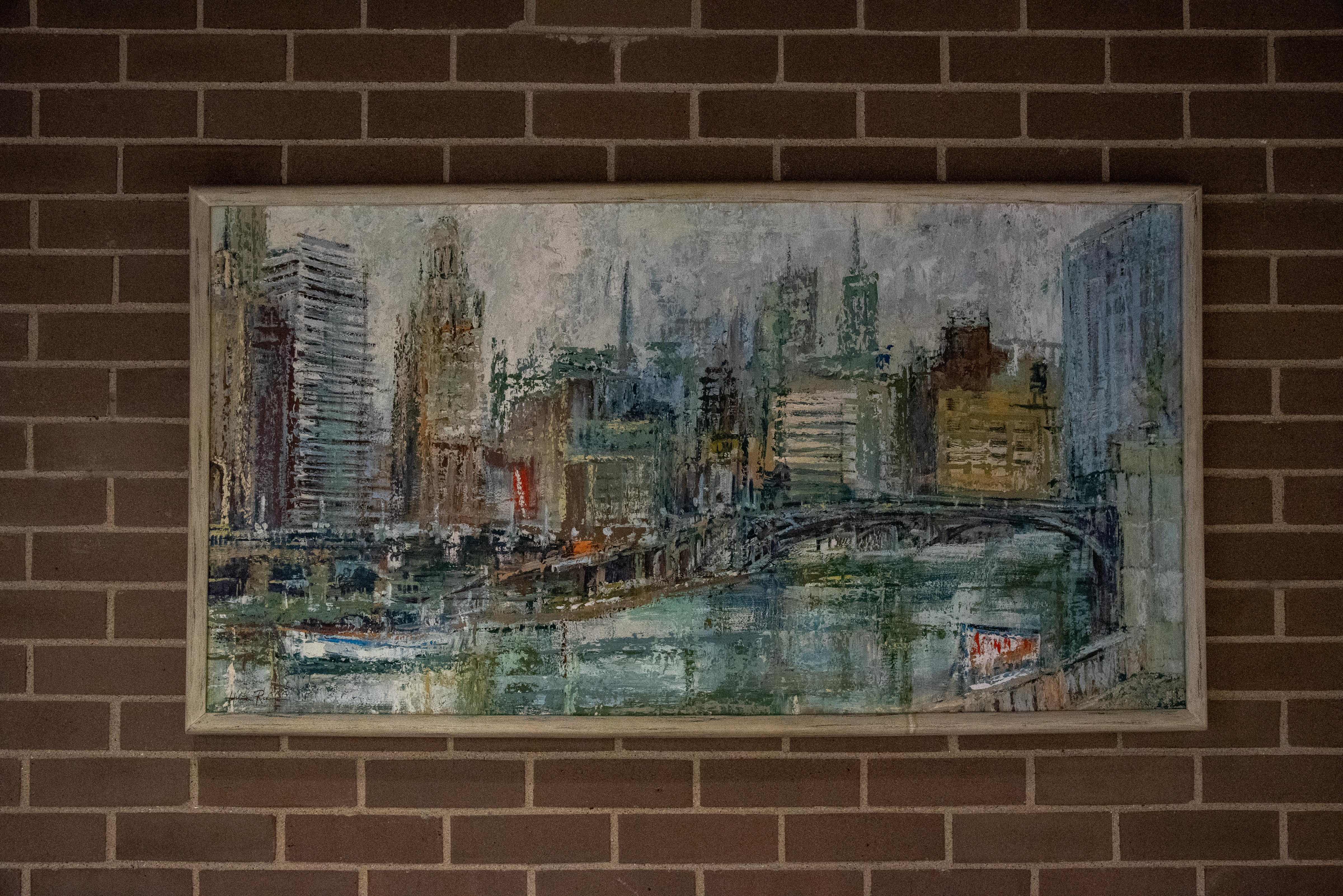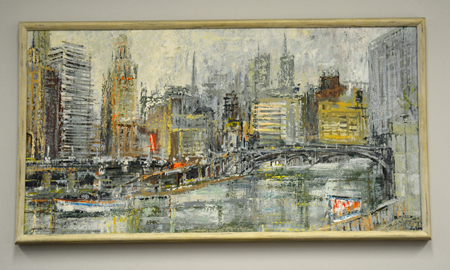Library Art: Chicago River
May 2, 2024

Walking through the library, you may have missed Hilda Rubin Pierce’s painting Chicago River. It’s in the hallway next to the Cosmos Room. We’re highlighting this beautiful work now in honor of Jewish American Heritage Month. Not only is Hilda a talented artist, she was also a survivor of the Holocaust. We can’t go into her whole story here, but she has a memoir, Hilda: A True Story of Terror, Tears, and Triumph, as well as an interview available on YouTube.
Escape from Austria
Hilda Rubin Pierce was born Hilda Harmel on July 8, 1921, in Vienna, Austria. Her parents owned a successful antique store, and she grew up surrounded by artists. In her memoir, she says that this upbringing made her certain as a child that she was destined to be an artist. She clearly succeeded, but her journey was much more complicated than she probably expected at the time.
In March 1938, when Hilda was 16, Nazi Germany invaded and annexed Austria in an event known as the Anschluss (German for “union”). Hilda’s family was Jewish, and this had immediate and terrifying consequences as the new government began their persecution. The family was soon forced to “donate” their store to the Nazi regime, and it was clear that things would only get worse. But in order to leave for the United States, as they had wanted to, Hilda and her family would need American citizens to sponsor their visas. They knew no one in the country, so Hilda looked through American phone books, found the addresses of families with the surname Harmel (her family’s surname), and mailed them out of the blue. She said she hoped they might be related and begged them for help.
They weren’t related, but the Harmels of America rose to the challenge anyway and agreed to sponsor her visa. In November 1939, Hilda arrived in New York Harbor and safely made her way to Chicago.
Becoming an Artist
Once in Chicago, Hilda was able to pursue her dreams of being an artist. She took classes at the Art Institute of Chicago and slowly became a prominent local artist—first in Chicago, then in Highland Park, and eventually in California. Of course, her difficulties with the Nazis and World War II weren’t over just because she came to the United States. She got engaged to her first husband, Charles Rubin, just two hours after meeting him to make it easier to help her parents immigrate.
While living in Highland Park, she taught at The Art Center Highland Park, and then Governor Adlai Stevenson visited her home to buy some of her paintings. In California, she had an art gallery of her own work. During that time, she was also chosen to do oil paintings and monoprints for two Carnival Cruise Lines ships. She created 1,246 works of art for one and 16 murals for the other, an incredible feat.
Oskar Kokoschka and Expressionism
In 1962, Hilda spent the summer in Salzburg, Austria, as one of hundreds of students studying watercolor at Oskar Kokoschka’s annual seminar. Oskar Kokoschka (1886 - 1980) was a writer, painter, and one of the most prominent Expressionist artists. Expressionism grew as an artistic style in the late 1800s and early 1900s, originating with artists like Vincent Van Gogh. It is characterized by its creative use of color in a way meant to evoke certain emotions rather than to accurately depict what the artist sees (think of Edvard Munch’s The Scream).
Both artists had some things in common—they were both Austrian and both faced Nazi persecution (the Nazi Party declared Oskar Kokoschka’s work “degenerate” in 1937)—and their painting also has many stylistic similarities. The influence he and the Expressionist style had on Hilda is clear. Chicago River depicts a real location, but not realistically. Look at the buildings at the far left of the painting. Individual brushstrokes go beyond the border of the structure. Hilda is quite literally not coloring between the lines to create a painting that produces a feeling of a rainy Chicago day. (If you’re interested in Oskar Kokoschka or Expressionism, check out the library’s books on the topics!)

Chicago River
For her studies, Hilda had to return to Austria. She wrote articles on the experience for Chicago Magazine and Chicago Daily News, discussing how it felt to return. Along with the unsettling memories, she wrote about feeling like and being treated like an American—even though she was in the country of her birth. America had, in the intervening years, become her home.
Though the circumstances of Hilda's immigration to America were the result of Nazi persecution, she was ultimately able to find success as an artist in her new home. Skokie Public Library is proud to consider her a local artist and to have such a beautiful example of her work on our wall.